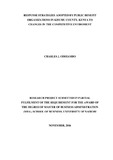| dc.description.abstract | World over, organizations are faced with myriads of challenges. These challenges, mainly brought about by shifting environmental conditions significantly impact organisation's quest for survival. The biggest challenge facing PBOs in Kenya has been to re-model their convectional business practices and embrace new business opportunities that make them competitive enough to counter the ever-changing turbulent environment within their areas of operation. The objective of the study was to establish the competitive strategies adopted by Public Benefit Organizations to changes in the competitive environment in Kisumu County, Kenya. A descriptive research design targeting (731) active public benefit organizations operating in Kisumu County was adopted in the study. This falls in line with the Public Benefit Organization’s Coordination Board report (2013). A cross sectional descriptive research design was adopted in this study. The researcher collected primary data by application of a semi-structured questionnaire. The study was conducted on 252 respondents but only 205 respondents managed to fill and return the questionnaires thereby attaining a response rate of 81.35%. The study findings on various environmental changes that affected the PBOs competitiveness revealed that diminishing donor funds, stakeholder sabotage, lack of government support, high community expectations, technological advancements, financial crisis and competition from other PBOs are the main pointers affecting the PBOs in Kisumu County, Kenya. One-sample t-test show that all factors under consideration in this study indicated a mean score of more than three, This suggests that the score are statistically significant. The implication of this is that most respondents felt that the environmental changes actually affect the PBOs and the response strategies are actually implemented within them. The study further established that PBOs in Kisumu County, Kenya are affected by the same environmental changes however, significant difference exists in the type of response strategies adopted by the PBOs. The study recommends that response strategies that benefit PBOs through reduced risk at the least cost possible should be implemented by the managers. In relation to policy, the findings shed light on the significance of pro-active strategies for environmental change management. Conceptually, the study only focused on response strategies adopted by PBOs in Kisumu County, Kenya, and there was no linkage to their performance. It would have been significant to relate the response strategies to the performance of the PBOs in Kisumu County, Kenya. | en_US |



